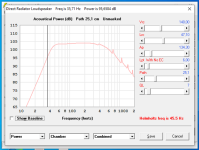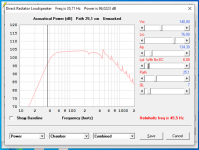Damping on the back of the cabinet to reduce mid band reflections emitted through the large port areas.This attached is the old design, if it is not a problem of orientation / proportions of the cabinet, on which aspect do you think I should focus?
Crossover and equalization.
Did you notice any difference in frequency response?It seemed like an important aspect to take into consideration because doing some simulations with Hornresp, I noticed an increase in resonances, while increasing the depth.
Could be room issues.For example when in the song by Adele - Rolling in the Deep, let's say the bass line starts, I have that feeling of confused sound.
Frequency and phase response of the individual components (including the port) and combined response, preferably outdoors to eliminate the room response.What types of measurements can be useful to try to understand?
Vertical and horizontal on and off axis measurements in 5 degree increments out to 180 degree off axis.
I tried to fill the bottom of the box with sound-absorbing material, unfortunately listening (more people to compare) did not give the desired results. Consider that a sloping wall had also been inserted into the rear wall of the cabinet.Damping on the back of the cabinet to reduce mid band reflections emitted through the large port areas.
Crossover and equalization.
Does moving the ports make sense? and where would be better to position them? (I also saw this influence in the simulations with hornresp, the best result seems to be when the port is close to the woofer)
In case the internal dimensions are exchanged, there is the possibility of moving both the woofers and the ports.
Here are the hornresp graphs showing the response with the depth at 47cm and with the depth at 76cm.Did you notice any difference in frequency response?


I can try, moving it out is very challenging, I can make a combined 'quasi-anechoic' measurement, which then has to be repeated several times, until it covers 180° in the X and Y axes, also quite challenging.Frequency and phase response of the individual components (including the port) and combined response, preferably outdoors to eliminate the room response.
Vertical and horizontal on and off axis measurements in 5 degree increments out to 180 degree off axis.
Thanks everyone.
Most of the reflections of concern would come from the back wall, not the bottom.I tried to fill the bottom of the box with sound-absorbing material, unfortunately listening (more people to compare) did not give the desired results.
That would direct the undesirable reflections more out of the bottom or top port.Consider that a sloping wall had also been inserted into the rear wall of the cabinet.
The center port position is increasing the woofer center to center distance, not good for midrange performance.
Can't identify the problem from what you have written, and with no measurements, don't know what you are hearing in your room or what the system response is.Does moving the ports make sense? and where would be better to position them?
Covering the ports for a listening test could tell you whether out of phase back wall reflections are a problem.
You have chosen a high tuning (Fb) of 45 Hz. Port output is 90 degrees off from the speaker output at the Fb of 40Hz, by ~40Hz and below it is 180 degrees out of phase, the woofers "unloaded".
That can sound bad on music that has content below Fb, for instance the song by Adele - Rolling in the Deep, you said sounded "confused" it has a fair amount of content down as low as 20Hz, more than an octave below Fb.
Art
Sorry, I meant depth.Most of the reflections of concern would come from the back wall, not the bottom.
These are the impedance measurements:
Sealed
Reflex
The listening test, with the reflex ports closed, did not make me or anyone else who listened perceive a greater clarity, while a lower "energy" in the bass certainly emerged.Covering the ports for a listening test could tell you whether out of phase back wall reflections are a problem.
Below are a couple of close-up measurements of the woofer taken with the microphone (reflex version), I don't consider them very reliable, because by varying the length of the port, from an electrical point of view a variation of the Fb was perceived, while from an acoustic point of view the microphone always shows something very similar, the point of minimum emission detected by the microphone does not coincide with the point of minimum impedance between the two peaks of the reflex detected with the impedance measurement.
Since the ports add ~+5dB of low frequency level, without their output bass would sound about half as loud in the 45Hz range, an obvious difference.The listening test, with the reflex ports closed, did not make me or anyone else who listened perceive a greater clarity, while a lower "energy" in the bass certainly emerged.
Your chart shows a good amount of single port output, the second port adds another 6dB.
Between 300-1000Hz, the woofer output has dropped ~-10dB (half as loud), at 600Hz the single port level nearly equals the woofer. Assuming the measurement is raw (no crossover), that loss seems indicative the output of the port(s) (possibly from back wall reflections) are out of phase with the woofer in the range of 350Hz and above.
Seeing the close-up measurements of the woofer output with the ports covered compared to open could verify the cause of the 300-1000Hz loss.
The HF horn output (and polarity) could have masked the woofer's upper loss in your listening test.
Art